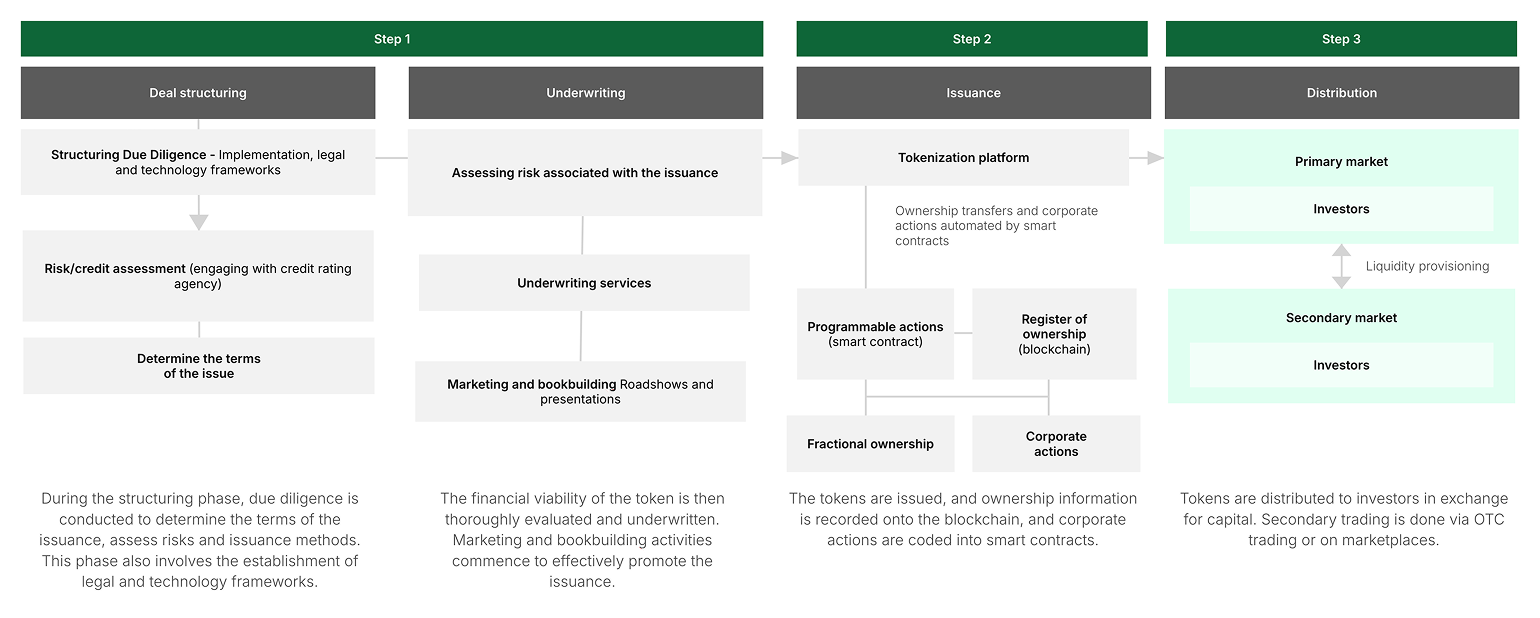

How tokenization works - inside the institutional workflow | AI generated image by XBTO
At its core, tokenization is the process of creating a digital representation, known as a “token,” of a real-world asset (RWA) or a right on a blockchain. These digital tokens act as certificates of ownership, verifiable through the blockchain, ensuring their authenticity, security, and traceability.
For institutions, the process involves more than just issuing tokens. It requires a comprehensive workflow of structuring, underwriting, issuance, distribution, and oversight, all designed to meet regulatory, operational, and investor requirements.
In this article, we’ll break down the full institutional tokenization process, step by step, showing how traditional assets are brought on-chain securely, compliantly, and efficiently.
Understanding how does tokenization work: The institutional RWA workflow
The institutional workflow for tokenization is a well-defined series of steps designed to ensure compliance, transparency, and operational efficiency. This approach takes a real-world asset and structures it within a robust legal, financial, and technological framework before issuing it as a digital asset.
The fundamental process begins with identifying the asset to be tokenized, such as real estate, a private equity fund, debt instruments, or commodities, ensuring compliance with regulatory requirements. Once identified, the asset moves through structured stages covering structuring, underwriting, digital asset issuance, and distribution.
Step 1 - Deal structuring: Laying the foundation
The tokenization journey begins with thorough preparation and due diligence. For institutions, this is the most critical phase - it defines the legal, financial, and technological architecture that underpins the entire issuance. A well-designed structure ensures investor confidence, regulatory compliance, and long-term scalability.
Every tokenization project starts with a deep assessment of the asset and its regulatory context. Legal teams define ownership rights, evaluate the jurisdiction of issuance, and determine whether the tokenized product qualifies as a security or another regulated financial instrument.
This includes:
- Reviewing title ownership and any encumbrances on the underlying asset.
- Verifying jurisdictional permissions (for example, under MiCA, ADGM, or Bermuda’s DABA frameworks).
- Mapping how the asset will be digitally represented and integrated into blockchain infrastructure.
The goal is to ensure that the asset is both legally sound and technologically compatible with blockchain-based issuance.
In cases where the tokenized asset carries revenue or repayment risk - such as property rentals, trade finance, or debt instruments - the project undergoes a formal credit evaluation. Collaboration with credit rating agencies or financial institutions helps determine the expected yield, collateral adequacy, and risk-adjusted return profile.
This step mirrors the role of due diligence in traditional structured finance - ensuring that the digital representation of the asset remains as credible and analyzable as a bond prospectus or private equity term sheet.
Next, issuers and arrangers define how investors will engage with the tokenized asset. This includes selecting the:
- Token type: equity, debt, or hybrid.
- Token standard: e.g., ERC-20 for fungible tokens or ERC-3643 for permissioned security tokens.
- Rights and obligations: voting, yield distribution, redemption, or transfer restrictions.
- Pricing and denomination: how the tokens will be valued, and in which currency or stablecoin subscriptions will be accepted.
Issuance terms also define transferability - whether tokens can trade freely or only among whitelisted investors (common in institutional-grade security tokens).
Underwriters or tokenization platforms may provide guaranteed placement of unsold tokens, ensuring the issuer meets their capital-raising target. This function brings capital markets discipline to blockchain issuances, reducing investor risk and ensuring smoother funding rounds.
In institutional workflows, this may involve co-underwriting arrangements, syndication, or insurance-backed guarantees, reflecting the same rigor as traditional securitization processes.
Finally, tokenized offerings enter the marketing and bookbuilding phase. Investor roadshows, presentations, and due diligence sessions help educate potential buyers and generate demand. Digital platforms increasingly automate this step - allowing investors to review offering documents, submit commitments, and finalize KYC before issuance day.
Step 2 - Issuance
After the structuring and underwriting phases are complete, the project moves into its technological execution: the actual creation and recording of digital tokens on the blockchain. This is the point where a traditional asset officially becomes a digitally native financial instrument.
This phase transforms legal agreements and economic terms into programmable code - bringing efficiency, transparency, and automation to asset management.
The process begins with minting digital tokens that represent ownership or rights linked to the underlying real-world asset. These tokens are created through smart contracts - self-executing programs embedded on a blockchain network.
Each smart contract encodes the rules governing the asset, including:
- Ownership rights: what each token represents - equity, debt, yield share, or a claim on an income stream.
- Transfer conditions: who can buy, sell, or hold the tokens, based on KYC/AML or investor qualification requirements.
- Automated functions: programmable actions such as coupon payments, dividend distributions, redemptions, or buybacks executed without intermediaries.
- Compliance parameters: restrictions based on geography, investor accreditation, or asset class - automatically enforced through permissioned smart contracts.
Smart contracts ensure that tokenized assets behave like regulated securities with built-in governance rather than unregulated crypto tokens. In advanced frameworks, issuers may use token standards like ERC-3643 or ERC-1400, which allow for permissioned, auditable transfers suitable for institutional use.
Once tokens are minted, ownership is recorded on the blockchain - creating an immutable and transparent record of all transactions. The blockchain ledger replaces traditional share registries or transfer agents, ensuring that every investor’s claim is traceable, timestamped, and verifiable.
Key institutional advantages:
- Transparency: All movements of the token can be verified in real time on-chain.
- Security: Each transaction is cryptographically signed, making data tampering virtually impossible.
- Dispute prevention: Because ownership records are immutable, conflicts over title or transfer can be resolved instantly through the ledger.
- Regulatory auditability: Supervisory authorities or auditors can verify the provenance and transaction history of tokens directly on-chain, reducing compliance friction.
To protect tokenized assets, institutions employ custody and key management solutions such as Fireblocks’ Multi-Party Computation (MPC) technology - removing single points of failure and safeguarding private keys across multiple secure environments.
Step 3 - Distribution
Once the tokens are created and verified on the blockchain, they must be distributed to investors and integrated into the broader financial ecosystem. This stage covers both primary market placement and secondary market liquidity, followed by ongoing lifecycle management to ensure compliance and performance throughout the token’s existence.
In the primary market, investors acquire tokens directly from the issuer during the initial offering - comparable to subscribing to a bond issuance or a private placement in traditional finance.
This step is facilitated by tokenization platforms that handle investor onboarding, subscription, and compliance workflows.
Typical components include:
- Investor onboarding: Institutions complete KYC (Know Your Customer) and AML (Anti-Money Laundering) checks through automated systems integrated with providers such as Sumsub or Chainalysis.
- Subscription and settlement: Investors transfer funds (often stablecoins such as USDC) to a regulated custodian or escrow account. Once verified, tokens are delivered to the investor’s segregated custody wallet.
- Smart contract allocation: Token delivery is automated, ensuring accurate, instant allocation and eliminating manual settlement delays.
This digital-first issuance model brings operational efficiency and transparency, reducing intermediaries while ensuring that every investor interaction is compliant and verifiable.
After the primary issuance, tokens enter the secondary market, where they can be freely traded - typically among verified participants on regulated exchanges, alternative trading systems (ATSs), or institutional OTC (over-the-counter) platforms.
In this phase:
- Liquidity providers and market makers (like XBTO’s Capital Markets division) facilitate two-way pricing and ensure orderly markets.
- Decentralized exchanges (DEXs) or permissioned blockchain venues may host compliant RWA markets, enabling peer-to-peer transactions governed by smart contract–based access controls.
- Settlement occurs on-chain in near real time, often within seconds, significantly improving liquidity and reducing counterparty exposure.
This secondary market layer is essential for institutional adoption - providing investors with exit flexibility and price discovery while ensuring compliance through on-chain monitoring.
Lifecycle management
Tokenization doesn’t end once tokens are distributed - it continues through ongoing asset administration, ensuring compliance, yield distribution, and liquidity provisioning throughout the asset’s life.
Compliance monitoring
Regular compliance checks are performed to ensure the tokenized asset remains aligned with regulatory frameworks and contractual obligations. This includes tracking investor eligibility, cross-border transfers, and ongoing disclosure requirements. Smart contracts can also automate compliance enforcement, preventing transfers to non-whitelisted wallets and providing an auditable trail for regulators.
Returns distribution
For income-generating assets such as real estate, private credit, or debt instruments, smart contracts automatically distribute returns (rental income, interest, or dividends) to token holders in digital currencies or stablecoins. This removes the need for manual payment processing, ensuring precision, transparency, and on-time disbursement.
Liquidity provisioning
Active secondary markets and market-making programs maintain liquidity, allowing token holders to liquidate or rebalance positions as needed. This supports an efficient trading environment and enhances the attractiveness of tokenized assets as investable products.
In short: The distribution and lifecycle management phase transforms tokenization from a static issuance into a living, tradable, and compliant financial instrument. It combines the capital markets infrastructure institutions rely on with the automation and efficiency that blockchain enables - bridging traditional finance with a new era of programmable assets.
Institutional oversight and compliance
For institutional tokenization to succeed, it must integrate robust oversight, security, and compliance mechanisms that match or exceed those of traditional finance. This clarity reduces risk and drives widespread adoption.
Custody and security
Custodians and validators are essential components of the ecosystem, bridging the gap between physical assets and their digital counterparts. These entities provide the infrastructure necessary to maintain the physical asset and secure the digital tokens. They play a crucial role in verifying and recording transactions in a decentralized manner, guarding against double-spending and fraud.
Regulatory compliance frameworks
Regulators globally are recognizing the transformative potential of tokenized assets and are actively developing frameworks to support this evolution. The European Union’s MiCA (Markets in Crypto-Assets) framework, for instance, provides clear guidelines for the treatment of digital assets, setting the stage for broader adoption across Europe. This regulatory momentum is key to fostering innovation while ensuring institutional safety.
Regular compliance monitoring is required throughout the lifecycle of the tokenized asset to ensure adherence to regulatory and contractual obligations. Token standards like ERC-1400 are designed specifically to integrate compliance requirements - such as investor accreditation, geographic restrictions, and AML checks - directly into the token's code.
Liquidity provisioning
Active secondary markets and market-making programs maintain liquidity, allowing token holders to liquidate or rebalance positions as needed. This supports an efficient trading environment and enhances the attractiveness of tokenized assets as investable products.
In short: The distribution and lifecycle management phase transforms tokenization from a static issuance into a living, tradable, and compliant financial instrument. It combines the capital markets infrastructure institutions rely on with the automation and efficiency that blockchain enables - bridging traditional finance with a new era of programmable assets.
Example: Tokenized real estate in action
Real estate is one of the most desired yet illiquid asset classes, making it a prime candidate for tokenization. Tokenizing assets explained best through a practical scenario highlights the benefits of the workflow.
Consider a property owner wishing to tokenize a luxury apartment complex to unlock $1 million in upfront capital.
- Deal Structuring (Step 1): A tokenization platform evaluates the property, performing comprehensive due diligence to determine its legal compliance and define the terms for fractional ownership. The terms dictate that the digital tokens will represent rental income streams.
- Underwriting (Step 1): The platform may guarantee underwriting services to ensure all tokens are successfully sold, securing the necessary funding for the owner. Marketing efforts target institutional investors and sophisticated retail investors seeking exposure to high-value real estate.
- Blockchain Issuance (Step 2): Digital tokens are minted, representing fractional shares of the property. Smart contracts are deployed to automatically distribute monthly rental income to token holders, ensuring transparency and timely payments. This process guarantees the tokenized ownership is recorded on the immutable blockchain ledger.
- Distribution & Secondary Trading (Step 3): The digital tokens are sold directly to investors in a primary offering. Crucially, investors receive rental income via smart contracts, and the tokens can subsequently be traded quickly and securely on regulated secondary marketplaces.
This workflow results in multiple benefits:
- Fractional Ownership: The asset, which typically requires significant capital, is now accessible to a global pool of investors with minimal capital requirements.
- Rental Income Automation: Smart contracts automate the distribution of rental income, ensuring transparency and efficiency for all stakeholders.
- Global Access and Liquidity: Geographically limited transactions are eliminated, and investors worldwide can participate in the trade of these assets, providing liquidity to an otherwise illiquid holding.
Process clarity drives institutional adoption
For decades, financial systems have struggled with slow, expensive, and opaque processes that are ill-suited for the global, digital world. Tokenization offers a glimpse into a future where finance is more equitable, inclusive, and efficient by redefining ownership, liquidity, and the structure of financial markets.
Understanding how does tokenization work at the institutional level is key to moving beyond skepticism and embracing the tangible benefits of digital assets. The clarity provided by a structured tokenization process - from rigorous deal structuring and underwriting to compliant digital asset issuance and robust secondary trading - is what drives institutional confidence. As technology matures, regulations harmonize, and the market continues to adopt these frameworks, the transformative potential of tokenization will continue to reshape industries.
The question is no longer if tokenization will revolutionize finance, but how quickly it will happen. For investors navigating this shift, mastering the end-to-end RWA tokenization workflow ensures a secure, compliant, and efficient path toward a digitized financial future.
The full breakdown
In our first article, "Navigating Crypto Volatility: The Advantages of Active Management," we explored how the high volatility and low correlation of digital assets with traditional asset classes create unique opportunities for active managers. We discussed how these characteristics enable active managers to execute tactical trading strategies, capitalizing on short-term price movements and market inefficiencies. Building on that foundation, we now turn our attention to the unique market microstructure of digital assets.
Conducive market microstructure of digital assets
The market microstructure of digital assets - a framework that defines how crypto trades are conducted, including order execution, price formation, and market interactions - sets the stage for active management to thrive. This unique ecosystem, characterized by its continuous trading hours, diverse trading venues, and substantial market liquidity, offers several advantages for active management, providing a fertile ground for sophisticated investment strategies.
24/7/365 market access
One of the defining characteristics of digital asset markets is their continuous, round-the-clock operation.
Unlike traditional financial markets that operate within specific hours, cryptocurrency markets are open 24 hours a day, seven days a week, all year round. This continuous trading capability is particularly advantageous for active managers for several reasons:
- Immediate response to market events: Unlike traditional markets that close after regular trading hours, digital asset markets allow managers to react immediately to breaking news or events that could impact asset prices. For instance, if a significant economic policy change occurs over the weekend, managers can adjust their positions in real-time without waiting for markets to open.
- Managing volatility: Continuous trading provides more opportunities to capitalize on price movements and volatility. Active managers can take advantage of this by implementing strategies such as short-term trading or hedging to mitigate risks and lock in gains whenever market conditions change. For instance, if there’s a sudden drop in the price of Bitcoin, managers can quickly sell their holdings to minimize losses or buy in to capitalize on the lower prices.
Variety of trading venues
The proliferation and variety of trading venues is another crucial element of the digital asset market structure. The extensive landscape of over 200 centralized exchanges (CEX) and more than 500 decentralized exchanges (DEX) offers a wide array of platforms for cryptocurrency trading. This diversity is beneficial for active managers in several ways:
- Risk management and diversification: By spreading trades across various exchanges, active managers can mitigate counterparty risk associated with any single platform. Additionally, the ability to trade on both CEX and DEX platforms allows managers to diversify their strategies, incorporating different levels of decentralization, regulatory environments, and security features.
- Arbitrage opportunities: Different venues often exhibit price discrepancies, presenting arbitrage opportunities. For example, managers can buy an asset on one exchange at a lower price and sell it on another where the price is higher, thus generating risk-free profits.
- Access to diverse liquidity pools: Multiple trading venues provide access to diverse liquidity pools, ensuring that managers can execute large trades without significantly impacting the market price.
Spot and derivatives markets (Variety of instruments)
The seamless integration of spot and derivatives markets within the digital asset space presents a considerable advantage for active managers. With substantial liquidity in both markets, they can implement sophisticated trading strategies and manage risk more effectively.
For instance, as of August 8 2024, Bitcoin (BTC) boasts a daily spot trading volume of $40.44 billion and an open interest in futures of $27.75 billion. Additionally, derivatives such as futures, options, and perpetual contracts enable managers to hedge positions, leverage trades, and employ complex strategies that can amplify returns.

Overall, the benefits for active managers include:
- Hedging and risk management: Derivatives offer a powerful tool for hedging against unfavorable price movements, enabling more efficient risk management. For instance, a manager holding a substantial amount of Bitcoin in the spot market can use Bitcoin futures contracts to safeguard against potential price drops, thereby enhancing risk control.
- Access to leverage: Managers can use derivatives to leverage their positions, amplifying potential returns while maintaining control over risk exposure. For instance, by employing options, a manager can gain exposure to an underlying asset with only a fraction of the capital needed for a direct spot purchase, thereby enabling more capital-efficient investment strategies.
- Strategic flexibility: By integrating spot and derivatives markets, managers can implement sophisticated strategies designed to capitalize on diverse market conditions. For instance, they may engage in volatility selling, where options are sold to generate income from market volatility, regardless of price direction. Additionally, managers can leverage favorable funding rates in perpetual futures markets to enhance yield generation. Basis trading, another strategy, involves taking offsetting positions in spot and futures markets to profit from price differentials, enabling returns that are independent of market movements.
Exploiting market inefficiencies
Digital asset markets, being relatively nascent, are less efficient compared to traditional financial markets. These inefficiencies arise from various factors, including regulatory differences, market segmentation, and varying levels of market maturity. For example:
- Pricing anomalies: Phenomena like the "Kimchi premium," where cryptocurrency prices in South Korea trade at a premium compared to other markets, create arbitrage opportunities. Managers can exploit these by buying assets in one market and selling them in another at a higher price.
- Exploiting mispricings: Active managers can identify and capitalize on mispricings caused by market inefficiencies, using strategies such as statistical arbitrage and mean reversion.
The unique aspects of the digital asset market structure create an exceptionally conducive environment for active management. Continuous trading hours and diverse venues provide the flexibility to react quickly to market changes, ensuring timely execution of trades. The availability of both spot and derivatives markets supports a wide range of sophisticated trading strategies, from hedging to leveraging positions. Market inefficiencies and pricing anomalies offer numerous opportunities for generating alpha, making active management particularly effective in the digital asset space. Furthermore, the ability to hedge and manage risk through derivatives, along with exploiting uncorrelated performance, enhances portfolio resilience and stability.
In our next article, we'll delve into the various techniques active managers employ in the digital asset markets, showcasing real-world use cases.
Read full disclaimer















